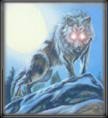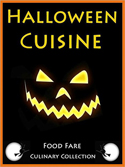|
By Shenanchie for Food Fare
Halloween is my favorite time of year. Not only because of Halloween, but because the weather finally changes from bad to good. Autumn is the most beautiful season of all to me. It signifies the passing of ugly summer heat, bringing cool breezes with brightly colored leaves. Autumn provides me with an overall sense of contentment. My autumn joy defines a true follower of the Halloween spirit. Enjoy the season... CONTENTS: Tricks & Trivia Famous Legends Graveyard Grub (Recipes) Halloween Words Ghoulish Links Terms of Use
All Hallows Eve was the name given to the day before the religious holiday called All Saints Day. The Roman Catholic and Anglican churches feasted and openly glorified God and all of his saints (known and unknown). The actual day was celebrated on November 1st in the Western part of England (as so decreed by Pope Gregory IV in the year 837). The term All Hallows Eve came from medieval England, and referenced the preceding evening before All Saints Day. The observance was also known as Allhallows and Hallowmas.
However, the celebrations are not to be confused with All Souls Day (November 2), which was another feast of the Roman Catholic Church in which those on earth prayed for the souls of the departed still suffering in purgatory. It was believed the dead would return to their earthly homes on All Souls Day. Families often left candles burning so the deceased could find their way home. However, in Irish and Scottish cultures, it is felt the devil, witches and spirits also roamed with the returning souls, so candle flames were extinguished until the All Souls Day festivities began.
Trick or treating has been a tradition in many cultures for centuries. Hundreds of years ago, people wore masks when droughts, diseases or other disasters struck. Folks believed that by wearing hideous masks, they would ward off the demons who brought misfortune, thus creating the nature of superstition which was so prevalent amongst people of medieval times and later.
In England, the poor once went from house to house singing for soul cakes made of bread and raisins. In some parts of England, "turnip" lanterns were placed on gateposts to protect homes from spirits. Other ancient English folklore includes the legend of elves riding on the backs of village cats. Villagers often locked up their felines so the elves could not catch them. In addition, children were told not to sit under Hawthorne trees because fairies loved to dance on the treetops. If fairies were to see the children, their tempers would soar. One old Halloween tradition was to give children beggars apples, buns and money to ensure they kept ghosts and goblins from playing tricks.
In Spain, people often placed cakes and nuts on graves during Halloween, thinking to bribe evil spirits. Additionally, the black cat is considered to be bad luck, especially when it crosses your path or comes into your home. A special pastry known as Bones of the Holy is eaten during Halloween in Spain, which consists of anise seed bread with orange glaze. The bread is also known as "Pan de Muerto" (Bread of the Dead). It is shaped into skulls or round loaves, with strips of dough rolled out and attached to resemble bones.
In a sinister twist, the Spanish Inquisition carried out Auto-Da-Fe ("act of faith") on All Saints Day. It was the public ceremony of executing people condemned to death by the Inquisition for heresy and other "sins." It was also a judicial ceremony of the Roman Catholic Church, and considered a solemn occasion. The condemned would be taken to a public place, where they would hear a sermon followed by the execution of their sentence (when they were commonly burned at the stake). The first recorded Auto-Da-Fe was held by the Inquisition in 1481; the last ceremony took place in the early 19th-century. The ceremony also occurred on Sunday's between Whitsunday and Advent.
In Poland, doors and windows are left open to welcome the spirits or visiting souls (quite a different reaction from other parts of Europe, where people are typically afraid of such things). However, Halloween is not celebrated in Poland as it is in other parts of the world. Most people are aware of what happens on Halloween, but traditions do not abound in Poland.
In South America, Halloween is great cause for celebration and is marked much in the same way as it is in the United States. Children dress in costumes and go door-to-door for treats, but it is felt the occasion is more of an American commercialization than a cultural milestone. In Columbia, however, visual representations related to Halloween - such as pumpkins, skeletons, spider webs and witches - are given their proper place in local celebrations.
In Switzerland, pumpkins are carved with candles placed inside.
PUMPKIN TRIVIA: Did you know?. . . . . . .

Jack O'Lantern: The word Jack O'Lantern was first used when a mysterious light began to flicker over the marshes in Ireland. When the light was approached, it would advance, always keeping out of reach. The light was also known as will o' the wisp. In Irish legend, when a man named Stingy Jack died he was considered too mean to go to heaven. He had also tricked the devil too many times to be invited into hell. In death, Jack had to walk the earth carrying a lantern made from a turnip with a single burning coal inside. The Irish spirit became known as Jack O'Lantern or Jack of the Lantern. It wasn't until immigrants brought the tradition to the United States that pumpkins were used as the Jack O'Lantern's. At the time, pumpkins were used because they were less expensive and more abundant than turnips.
Dracula: Vlad Dracula was a real person, a Romanian prince who lived during the 15th century. Vlad was noted for his military finesse against Turkish invasions, and is still considered a hero in Romania today. However, Vlad was also a mass murderer whose favorite form of killing was impalement. Legend has it he also enjoyed drinking the blood of his victims and chopping their remains to mix into his food. Thus the vampire stories were born. The actual word "vampire" derives from a Slavic word "vampyre," which means "flying between" and "drinking."
Frankenstein: The word Frankenstein literally means "stone of the Franks" in the German language. In 500 A.D., the Franks seized control of Gaul, which was then part of the Roman Empire. Included in the conquest was a quarry in the vicinity of what is now Darmstadt, Germany. One of their knights, Arbogast Von Frankenstein, was a voracious warrior from the area also known as the first person to use the surname of Frankenstein. In the 13th-century, a castle was built near Darmstadt, named for Baron von Frankenstein.
In 1814, English novelist Mary Shelley traveled down the Rhine River in Germany with her husband. It is said one of their stops was near the ruins of Frankenstein Castle. Some four years later, she published her novel Frankenstein, which has since become a literary classic through the ages to the modern day. The novel recounts the life of Victor Frankenstein, a doctor who creates a man from stolen body parts in his laboratory, and then reels in disgust from his creation for fear he has spawned a monster.
Jack The Ripper: Never caught or punished for his horrific deeds, Jack the Ripper was not a fictional concoction but a real person. The name summons images of foggy London alleyways, of a man slinking about in a long cape with shifty eyes barely discernible in the shadows, and of the hapless women who met their ends on the wrong side of a knife wielded by a psychotic serial killer. Long before such a pseudonym became commonplace in our modern day and age, Jack the Ripper was the epitome of the definition more than one hundred years ago. Available information about Jack the Ripper is seemingly endless, from print books to web sites and films. Yet none of these sources have irrefutably proven the identity of Jack the Ripper. Some writers and "Ripperologist's" claim to have the solution to the century-old mystery (each one differing in their findings), yet it is doubtful any of the individual conclusions will ever be regarded as collectively legitimate.
The remains of Mary Kelly were discovered in her room at Miller's Court in Whitechapel on November 8, 1888. Her murder was purported to be the last at the hands of the Ripper, and by far the most brutal. Apparently Kelly owed back rent for her lodgings and when the landlord came to collect late in the morning of the 8th, he happened to look inside her room through a window and espied the grotesque tableau upon the bed... Excerpt from Jack the Ripper by Deborah O'Toole (©2012-2013); Kindle Edition, ASIN: B0092R0SYK. Used with permission.
Werewolves: Werewolves are beasts who have no known origins. The term lycanthropy is also used in describing the werewolf, defined as originating from the Greek words "lyoki" (wolf) and "anthropos" (man). Further definition of the term lycanthropy means "a human being that has changed into a wolf, or is capable of assuming the form of a wolf, held possible by witchcraft or other magic." Werewolves are a cross-between a human man and an enraged beast, which kills with bloody violence.
There is also an authentic medical condition known as Lycanthropic Disorder, in which the patient believes that he or she is a werewolf. Werewolves are also immune to aging and most physical diseases, and are said to transform from human to wolf when the moon is full. The only way to destroy a werewolf is with a silver bullet.
Witches:
Types of witches include Kitchen Witches (practicing by home and hearth); Wicca (witches who practice by the elements, the Ancient Ones and nature, typically healers working with medicinal plants and trees); Gardenarian (witches who follow a structured ceremony and customs); British Traditional (a combination of Celtic and Gardenarian beliefs); Alexandrian (modified Gardenarian's); Dianic (varying traditions with primary focus on the Goddess); Solitary (a witch who practices alone) and Strega (originally from Italy; known to be the smallest practicing group with a craft wise and beautiful).
Try our selection of Halloween recipes...
Click here for even more fiendish treats...
Many Halloween words are commonplace (such as trick or treat and boo!), but there are several words which actually originated many centuries ago. Below is a brief list of words, including where they came from and what they originally meant.
Bat: Middle English bakke.Devil: Greek diablos.Fright: Old English fryhto.Ghost: Old English ghast.Goblin: French gobelin.Graveyard: Old English word grafan, meaning "to dig."Haunt: French hanter.Lucifer: Latin for light bringer.Monster: Roman monstrum.Phantom: Greek phantasma.Scary: Old Norse word skiarr, meaning timid.Skull: Scandinavian word skoltr.Spooky: Dutch word spook, meaning ghost.Vampire: Hungarian vampir.Witch: Old English wicce.
Click on the link to take you there...
*Copyright Food Fare*
You are free to use the material in this article as reference, but if you happen to use our direct wording, we would appreciate the credit. Thank you!
If you have comments or questions about All Hallows Eve, please click here to send us a message.
HALLOWEEN CUISINE:
Halloween Cuisine contains a brief history of Halloween, traditions celebrated around the globe, famous ghoulish legends, haunted domains, pumpkin information and trivia, Halloween recipes, common Halloween words and their origins, and links for further study.
The Kindle and Nook editions of Halloween Cuisine contain bonus recipes and information. If preferred, the online articles are still freely available for reference.
Click here for more information.
Web Design: Webs Divine
|


 During
the mythical transformation from man to beast, the person afflicted with
lycanthropy experiences extremes in pain as his bones twist and change
shape. The skull extends and the skin stretches, making the head take on huge
proportions. Once the werewolf has taken form and is on the loose, he will stalk
an obvious prey and then attack. The werewolf rips the throat of his victim,
often eating the remains or leaving the disemboweled body to decay. The person
so attacked by the werewolf will be left in a living hell as he or she will
remain walking the earth, haunting the human form of the werewolf. The wandering
dead will torment the human werewolf, trying to stop him from hideously
transforming and killing again.
During
the mythical transformation from man to beast, the person afflicted with
lycanthropy experiences extremes in pain as his bones twist and change
shape. The skull extends and the skin stretches, making the head take on huge
proportions. Once the werewolf has taken form and is on the loose, he will stalk
an obvious prey and then attack. The werewolf rips the throat of his victim,
often eating the remains or leaving the disemboweled body to decay. The person
so attacked by the werewolf will be left in a living hell as he or she will
remain walking the earth, haunting the human form of the werewolf. The wandering
dead will torment the human werewolf, trying to stop him from hideously
transforming and killing again. Witchcraft
is termed as "sorcery, the magical manipulation of supernormal forces through
the use of spells and the conjuring of spirits." Many people in the dark ages
thought of witchcraft as evil magic, heresy and devil-worship. The general fear
and belief that women could be witches was proven with the Salem Witch Trials in
the 1700's, when women were burned at the stake after being condemned as
witches.
Witchcraft
is termed as "sorcery, the magical manipulation of supernormal forces through
the use of spells and the conjuring of spirits." Many people in the dark ages
thought of witchcraft as evil magic, heresy and devil-worship. The general fear
and belief that women could be witches was proven with the Salem Witch Trials in
the 1700's, when women were burned at the stake after being condemned as
witches.
